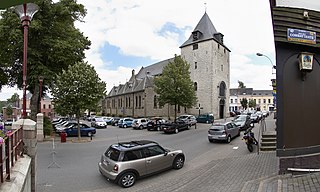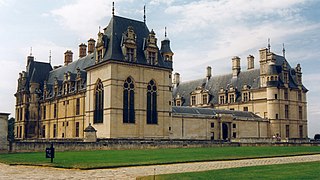
Tapestry is a form of textile art, traditionally woven by hand on a loom. Normally it is used to create images rather than patterns. Tapestry is relatively fragile, and difficult to make, so most historical pieces are intended to hang vertically on a wall, or sometimes horizontally over a piece of furniture such as a table or bed. Some periods made smaller pieces, often long and narrow and used as borders for other textiles. Most weavers use a natural warp thread, such as wool, linen, or cotton. The weft threads are usually wool or cotton but may include silk, gold, silver, or other alternatives.

La Hulpe is a municipality of Wallonia in the Belgian province of Walloon Brabant, 20 km south-east of the centre of Brussels, but only about 3 km from the edge of the Brussels-Capital Region. On January 1, 2007, La Hulpe had a total population of 7,309. The total area is 15.60 km², including 3 km² of the Sonian Forest; this gives a population density of 463 inhabitants per km².

The Gobelins Manufactory is a historic tapestry factory in Paris, France. It is located at 42 avenue des Gobelins, near Les Gobelins métro station in the 13th arrondissement of Paris. It was originally established on the site as a medieval dyeing business by the family Gobelin.

Bernard van Orley, also called Barend or Barent van Orley, Bernaert van Orley or Barend van Brussel, was a versatile Flemish artist and representative of Dutch and Flemish Renaissance painting, who was equally active as a designer of tapestries and, at the end of his life, stained glass. Although he never visited Italy, he belongs to the group of Italianizing Flemish painters called the Romanists, who were influenced by Italian Renaissance painting, in his case especially by Raphael.

Adam Frans van der Meulen or Adam-François van der Meulen was a Flemish painter and draughtsman who was particularly known for his scenes of military campaigns and conquests. Van der Meulen also painted portraits, hunting scenes, paintings of chateaux and landscapes. He created designs for prints and cartoons for tapestries.

Jean-Baptiste Oudry was a French Rococo painter, engraver, and tapestry designer. He is particularly well known for his naturalistic pictures of animals and his hunt pieces depicting game. His son, Jacques-Charles Oudry, was also a painter.

Jean-Baptiste Belin de Fontenay I (1653–1715), also called ‘Jean-Baptiste Belin the Elder’, was a French painter who specialized in flowers.

Alexandre-François Desportes was a French painter and decorative designer who specialised in animals.

The Diana of Versailles or Artemis, Goddess of the Hunt is a slightly over-lifesize marble statue of the Roman goddess Diana with a deer. It is currently located in the Musée du Louvre, Paris. The statue is also known as Diana with a Doe, Diana Huntress, and Diana of Ephesus. It is a partially restored Roman copy of a lost Greek bronze original attributed to Leochares, c. 325 BC.

The Château d'Écouen is an historic château in the commune of Écouen, some 20 km north of Paris, France, and a notable example of French Renaissance architecture. Since 1975, it has housed the collections of the Musée national de la Renaissance.

Claude Lefèbvre was a French painter and engraver.

Nicasius Bernaerts, Monsù Nicasio or simply Nicasius was a Flemish painter of animals, hunting pieces and flowers who had an international career in Italy and Paris. He worked for the French court and provided tapestry designs to the Gobelins Manufactory.

Brussels tapestry workshops produced tapestry from at least the 15th century, but the city's early production in the Late Gothic International style was eclipsed by the more prominent tapestry-weaving workshops based in Arras and Tournai. In 1477 Brussels, capital of the duchy of Brabant, was inherited by the house of Habsburg; and in the same year Arras, the prominent center of tapestry-weaving in the Low Countries, was sacked and its tapestry manufacture never recovered, and Tournai and Brussels seem to have increased in importance.

The family of de Pannemaeker or de Pannemaker were tapestry weavers from the Southern Netherlands, more or less equivalent to modern-day Belgium. Pieter de Pannemaeker, working from Brussels, was a celebrated weaver who, for European royalty, created tapestries resplendent with gold and silver threads, and expensive fine silks and woollen items. In 1520, Pieter de Pannemaeker commissioned the artist Bernard van Orley to make tapestry cartoons for his workshop. A surviving fragment depicts the Allegory of the Four Winds. Pannemaeker was court weaver to Margaret of Austria, Regent of the Southern Netherlands, who commissioned the Passion in four parts, and in 1523, she ordered an imposing dais made up of three tapestries, which later featured in the abdication ceremony of Emperor Charles V.

The Livre de chasse is a medieval book on hunting, written between 1387 and 1389 by Gaston III, Count of Foix, also known as Fébus or Phoebus, and dedicated to Philip the Bold, Duke of Burgundy. Fébus was one of the greatest huntsmen of his day and his treatise became the standard text on medieval hunting techniques. It was described by scholar, Hannele Klemettilä, as "one of the most influential texts of its era".

Alexis-Joseph Mazerolle was a French painter.

Richard van Orley or Richard van Orley II was a Flemish painter, draughtsman, printmaker. His collaboration with his brother Jan van Orley, who was one of the major figures of Flemish tapestry design in the late 17th and early 18th century, as a tapestry cartonnier is not proven. For an essential study on the artist, see: Alain Jacobs, Richard van Orley Bruxelles 1663–1732, Brussels, Royal Library 2003, 173 pages. Richard van Orley was an important engraver and is particularly known for his prints after drawings by Augustin Coppens documenting the devastating effect of the Bombardment of Brussels by French troops in 1695.

Lodewijk van Schoor was a Flemish painter, draughtsman and designer of tapestries. Van Schoor was one of the major figures of Flemish tapestry design in the late 17th and early 18th century, together with Victor Honoré Janssens and Jan van Orley.

The Oyster Dinner is a 1735 painting by Jean-François de Troy. It and Nicolas Lancret's The Ham Dinner were commissioned by Louis XV to decorate the dining room in the lesser apartments at the Palace of Versailles. It includes the first appearance of a champagne bottle in painting. Both paintings are now in the Musée Condé.
A pavillon de chasse in France is a building dedicated to venery. They are built in areas where hunts take place regularly. The history of pavillons de chasse is a part of the history of venery and hunting with hounds and its role in terms of leisure purposes or summit meetings, and more broadly in the stewardship of the hunt. They are sometimes referred to as Rendez-vous de chasse.

































